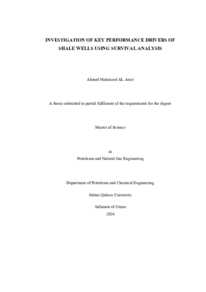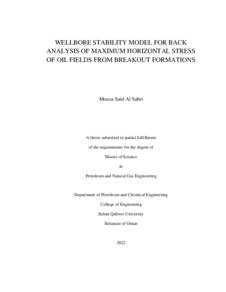وثيقة
Investigation of key performance drivers of shale wells using survival analysis.
المصدر
Master's thesis
الدولة
Oman
مكان النشر
Muscat
الناشر
Sultan Qaboos University
ميلادي
2024
اللغة
الأنجليزية
الموضوع
نوع الرسالة الجامعية
Master's thesis
الملخص الإنجليزي
This master thesis presents a comprehensive survival analysis examining two datasets
to understand shale reservoir dynamics and identify the influence of various
parameters on well performance. The first Case Study focuses on key reservoir and
operational properties and their influence on the event of cumulative carbon dioxide
injection into shale reservoirs. Results from Case Study 1 display significant findings
regarding numerous covariates including matrix porosity, fracture porosity, and matrix
permeability, casting light on their influence by employing the Kaplan-Meier (KM)
curve, Cox Proportional Hazards (CPH) model, and Accelerated Failure Time (AFT)
models. The Kaplan Meier produced resembles the shape of an inverse sigmoid
function to reveal distinct injection phases, while the CPH model identifies influential
covariates like fracture permeability and SRV fracture permeability which reduce the
hazard ratio, hence increasing the survival time. The AFT model validates some of
the covariates’ effects on injection timing, emphasizing SRV fracture permeability's
role in increasing the survival times. Integration of model results enhances
understanding for optimizing injection strategies and ensuring sequestration
success in shale formations.
The second case study analyses 42 gas-producing shale wells on a second dataset
comprising geological, reservoir, and operational parameters, with analysis centred on
gas volume production. Kaplan-Meier curves are constructed to visualise survival
probabilities for individual wells, demonstrating a predictable linear decline over time.
Cox Proportional Hazard and Accelerated Failure Time models are then employed to
assess the impact of formation types on gas volume depletion. Results from the CPH
model indicate significant influences of formation types on gas volume depletion
hazard. Notably, Haynesville and Marcellus Shale formations produce a 46% and 53%
reduction in hazard. Similarly, the AFT model reveals the acceleration or deceleration
of gas volume depletion time, with coefficients indicating the influence of formation
types by prolonging the well’s lifetime before attaining gas depletion thresholds.
Overall, this thesis contributes to the understanding of shale well performance and
emphasise the requirement for comprehensive analysis incorporating various
reservoir and operational factors. It also confirms the potential of survival analysis
techniques in optimizing production strategies and enhancing reservoir management
in shale formations.
الملخص العربي
تقدم هذه الرسالة دراسة شاملة عن تحليل بقاء الآبار الصخرية المنتجة للغاز الطبيعي، وذلك من خلال فحص مجموعتين من البيانات لفهم ديناميكيات الخزان الصخري وتحديد المتغيرات المؤثرة على حدث الحقن التراكمي لثاني اكسيد الكربون في خزانات الصخور الرسوبية.
قالب العنصر
الرسائل والأطروحات الجامعية


